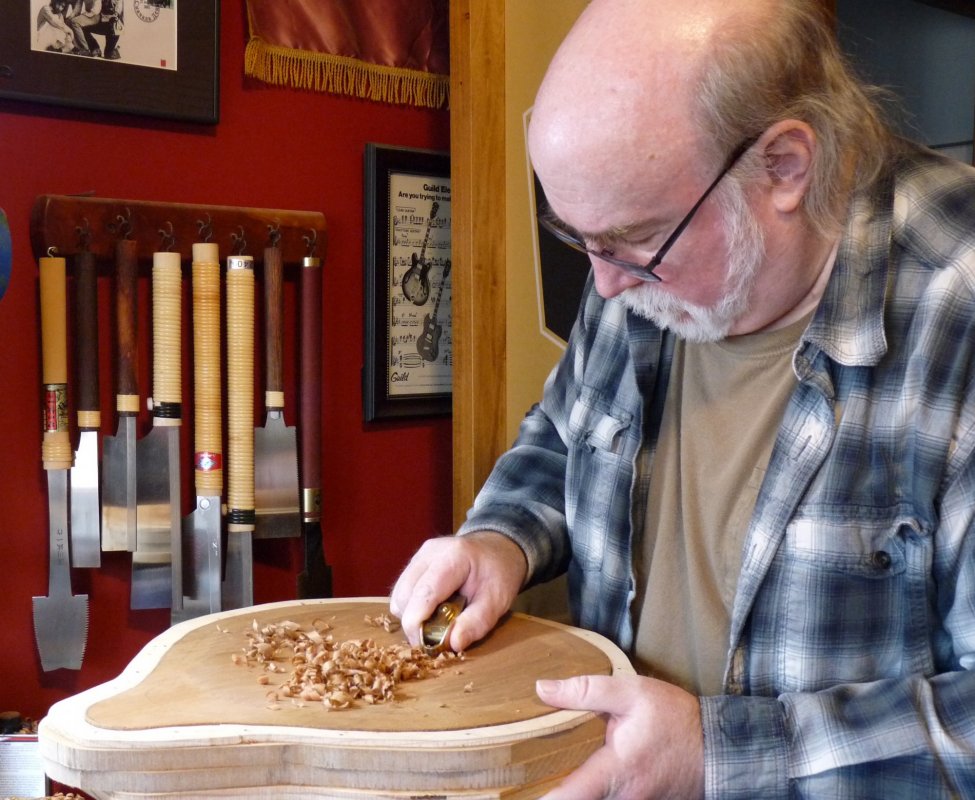Actually, that raised a question for me about whether salvaged cedar would still have a smell to it. I imagine GG is right, though!I bet the cedar smells nice as you're carving it.
You are using an out of date browser. It may not display this or other websites correctly.
You should upgrade or use an alternative browser.
You should upgrade or use an alternative browser.
AHG octave mando build
- Thread starter AcornHouse
- Start date
AcornHouse
Venerated Member
If you’ve ever sharpened a cedar pencil, one of those natural ones, not one painted yellow, you’ll know the smell.Actually, that raised a question for me about whether salvaged cedar would still have a smell to it. I imagine GG is right, though!
Prince of Darkness
Senior Member
- Joined
- Feb 17, 2018
- Messages
- 3,600
- Reaction score
- 9,564
- Location
- Boddam, North East Scotland.
- Guild Total
- 2
I always find it interesting that Andy is generally described as IrishA rabbit hole veer - I didn't think book author Graham McDonald was retired member @Graham but I had to check. They aren't the same person but the forward to the book was written by Andy Irvine. Bassist Andy Irvine is perhaps the most famous player of a Betts Bass (my custom bass is a Betts) so I checked that out. Forward writer Irvine is an Irish singer not an American bassist. Oh well.
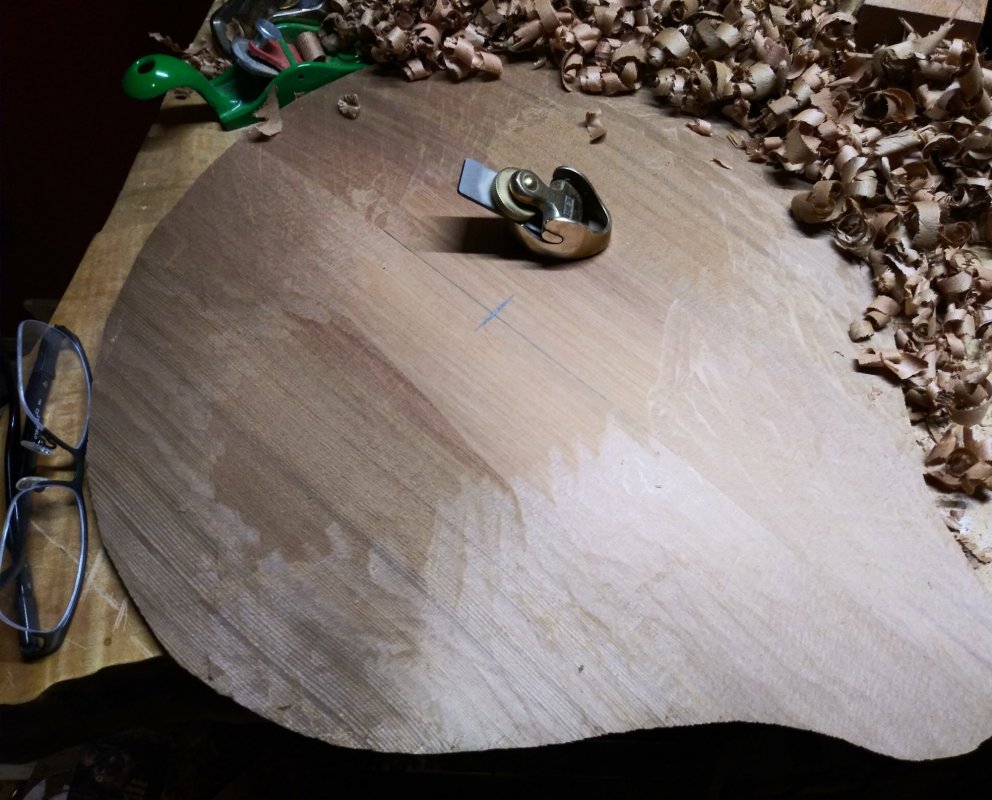
Is that the primary carving tool? If you have some spare time could you pose with it as if you were carving something. Thank you.
AcornHouse
Venerated Member
With the top shaped, it's time to work on the underside. I use a very old technique from the violin world (Probably predating them, as well) to gauge the depth and hog out some of the waste.
I set up a post on the drill press a predetermined distance from the drill bit, in this case 7mm. So each time I plunge the bit in, it will only go as deep as 7mm from the top, which is now on the bottom. But I use a forstner bit so it also gets rid of a lot of the waste. Then I carve until the bits center holes are all gone. That lets me know I have a 7mm thick top. (And then I can do further thinning where appropriate.)
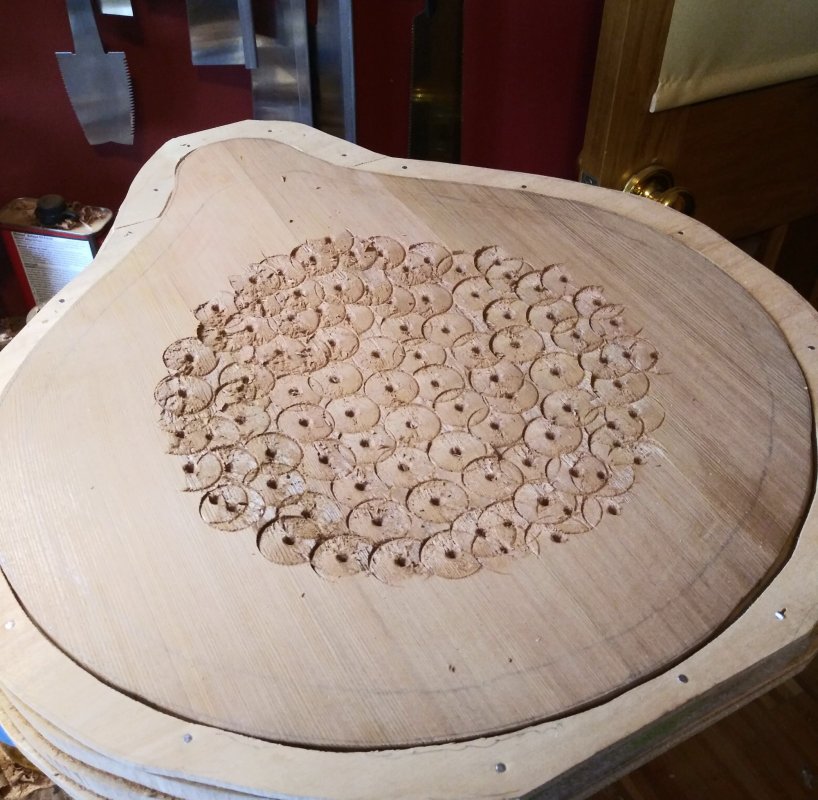
I set up a post on the drill press a predetermined distance from the drill bit, in this case 7mm. So each time I plunge the bit in, it will only go as deep as 7mm from the top, which is now on the bottom. But I use a forstner bit so it also gets rid of a lot of the waste. Then I carve until the bits center holes are all gone. That lets me know I have a 7mm thick top. (And then I can do further thinning where appropriate.)

GGJaguar
Reverential Member
For a second there, I thought it was some fancy Celtic pattern you were starting. I should read first and look at photos second.
AcornHouse
Venerated Member
There was one small issue with the procedure. It hasn't been as big a deal with the spruce top, but with cedar, being a little softer, the post that the top rested on dimpled the surface as the drill pressed down on it.
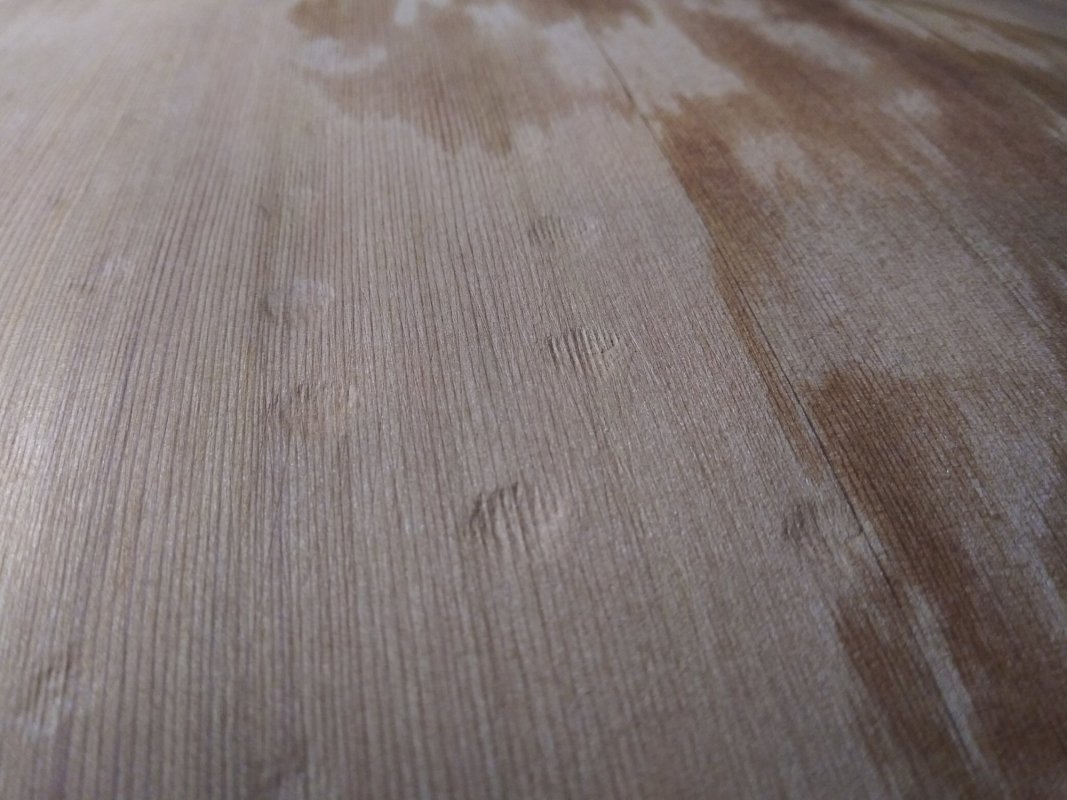
But those were soon ironed out. Literally! As long as it was just compressions with no actual torn fibers, a little moisture from a damp towel and heat from an iron easily uncompressed the wood, causing it to swell back into form.
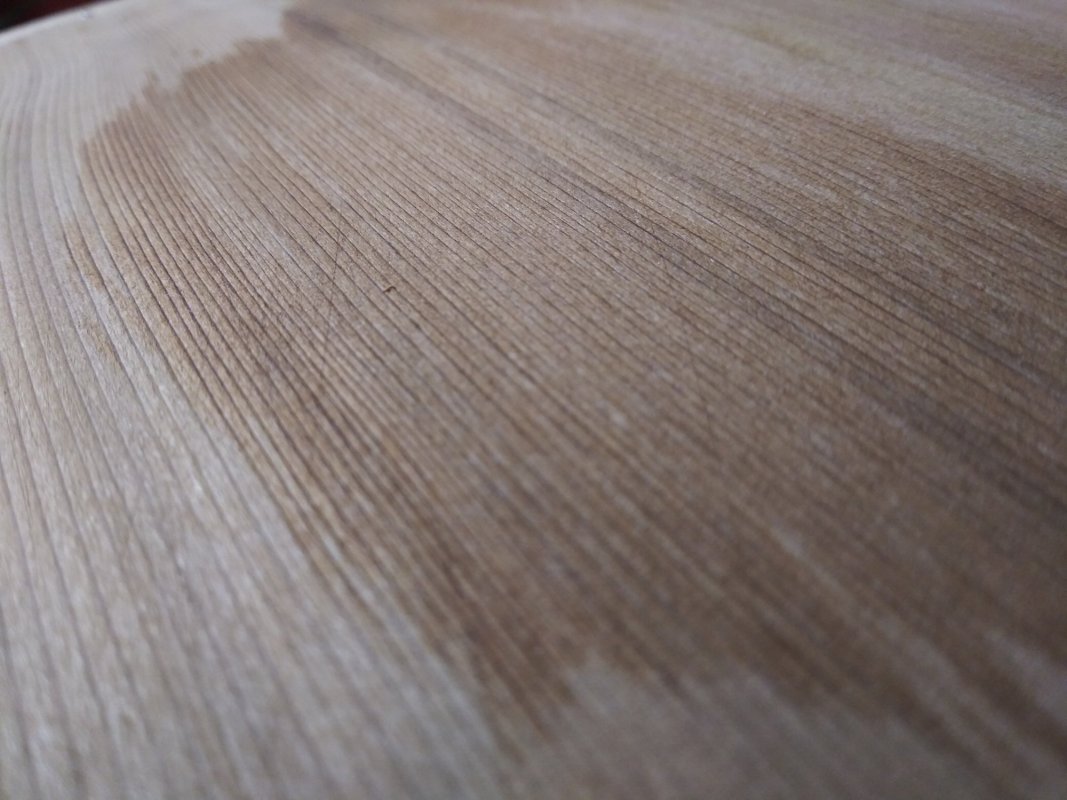

But those were soon ironed out. Literally! As long as it was just compressions with no actual torn fibers, a little moisture from a damp towel and heat from an iron easily uncompressed the wood, causing it to swell back into form.

That cedar is stunning!There was one small issue with the procedure. It hasn't been as big a deal with the spruce top, but with cedar, being a little softer, the post that the top rested on dimpled the surface as the drill pressed down on it.
But those were soon ironed out. Literally! As long as it was just compressions with no actual torn fibers, a little moisture from a damp towel and heat from an iron easily uncompressed the wood, causing it to swell back into form.

AcornHouse
Venerated Member
Not my idea. It’s an old trick in woodworking circles.I've never heard of ironing a top! Clever!
Minnesota Flats
Senior Member
- Joined
- Oct 3, 2015
- Messages
- 1,393
- Reaction score
- 1,308
Looks nice!
Viewing your PICs of carving the top/back made me remember a documentary I saw years ago. It was a deep dive into why Stradivarius violins sound so good. They showed a guy in Italy trying to reproduce one by hand: the pains-taking process of carving the top and back and then fine tuning them to maximize tone.
His finished product was excellent, but still couldn't match the tone of the Stradivarius. If memory serves, they theorized that part of the reason was that the wood used on the attempted reproduction hadn't had as long to age and mellow. But they also said that the wood used in the Stradivarius instruments had a unique grain structure because the trees it came from had lived through several extremely cold winters which caused the grain to be tighter than that of any trees available today.
Here’s a link to a study write up regarding this notion:

 journals.plos.org
journals.plos.org
Viewing your PICs of carving the top/back made me remember a documentary I saw years ago. It was a deep dive into why Stradivarius violins sound so good. They showed a guy in Italy trying to reproduce one by hand: the pains-taking process of carving the top and back and then fine tuning them to maximize tone.
His finished product was excellent, but still couldn't match the tone of the Stradivarius. If memory serves, they theorized that part of the reason was that the wood used on the attempted reproduction hadn't had as long to age and mellow. But they also said that the wood used in the Stradivarius instruments had a unique grain structure because the trees it came from had lived through several extremely cold winters which caused the grain to be tighter than that of any trees available today.
Here’s a link to a study write up regarding this notion:
A Comparison of Wood Density between Classical Cremonese and Modern Violins
Classical violins created by Cremonese masters, such as Antonio Stradivari and Giuseppe Guarneri Del Gesu, have become the benchmark to which the sound of all violins are compared in terms of their abilities of expressiveness and projection. By general consensus, no luthier since that time has...
freddyfingers
Member
- Joined
- Jul 13, 2019
- Messages
- 218
- Reaction score
- 173
- Location
- Virginia. The State, not the woman.
- Guild Total
- 5
I am enjoying this. Had an octave made for me a few years back, and the person that made it did not follow this process at all. Live and learn I do.
AcornHouse
Venerated Member
Octave mandos seem to be the least codified of the mandolin family. All types of shapes, flattops, arched tops, pressed tops, etc.I am enjoying this. Had an octave made for me a few years back, and the person that made it did not follow this process at all. Live and learn I do.
Minnesota Flats
Senior Member
- Joined
- Oct 3, 2015
- Messages
- 1,393
- Reaction score
- 1,308
I liked, but was especially impressed by the guy playing bass.
Minnesota Flats
Senior Member
- Joined
- Oct 3, 2015
- Messages
- 1,393
- Reaction score
- 1,308
AcornHouse
Venerated Member
AcornHouse
Venerated Member
Even got a Short made.
GGJaguar
Reverential Member
davismanLV
Venerated Member
- Joined
- Mar 24, 2011
- Messages
- 19,416
- Reaction score
- 12,305
- Location
- U.S.A. : Nevada : Las Vegas
- Guild Total
- 2
Okay, thanks for that info, Chris!! I was wondering how you'd know the depth when you're shaving!!With the top shaped, it's time to work on the underside. I use a very old technique from the violin world (Probably predating them, as well) to gauge the depth and hog out some of the waste.
I set up a post on the drill press a predetermined distance from the drill bit, in this case 7mm. So each time I plunge the bit in, it will only go as deep as 7mm from the top, which is now on the bottom. But I use a forstner bit so it also gets rid of a lot of the waste. Then I carve until the bits center holes are all gone. That lets me know I have a 7mm thick top. (And then I can do further thinning where appropriate.)
AcornHouse
Venerated Member
After the rough carving, it’s long reach calipers to get to the final thickness. Taking lots and lots of readings. Over and over and over and…Okay, thanks for that info, Chris!! I was wondering how you'd know the depth when you're shaving!!
